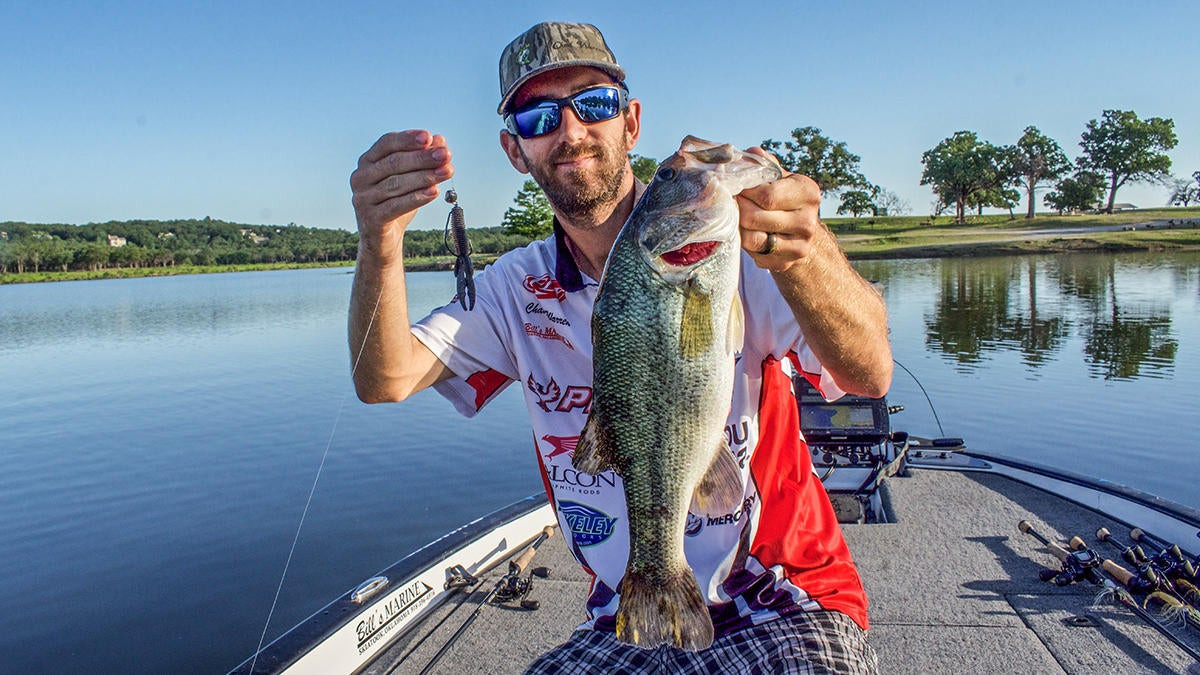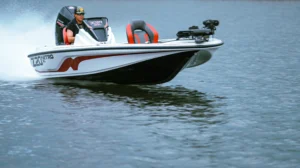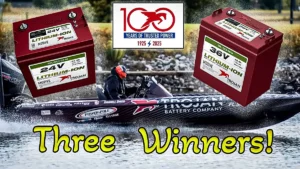Productive shallow patterns are sought after like the last slice of pizza for most bass fishermen by the time June rolls around. The last wave of spawning fish or fry guarders leave the bank and many anglers lose touch with the fish for a few weeks. You’ll start seeing wads of bass boats out looking at their electronics and while there are a few fish offshore, the giant schools of deep bass we dream of haven’t quite shown up.
It’s during this post-spawn funk that pro angler Chad Warren uses a swinging jighead to capitalize on overlooked shallow bass. Warren competes on the FLW Pro Circuit and has not only found success with this technique throughout his home state of Oklahoma, but on a myriad of man-made lakes across the country.
“This pattern has produced some of the biggest bags of fish I’ve ever caught in May, June and July,” Warren said. “And they’ve all come in less than five feet of water regardless of the summertime heat.”
Why stay shallow with a swinging jighead
Swinging jigheads, hardheads or wobbleheads as they are sometimes referred to are no longer a secret amongst avid bass anglers. Legends like Tommy Biffle and Mark Davis have shown the effectiveness of this technique time and again, but the chatter on wobbleheads usually quiets as summertime sets in. This is Warren’s favorite time to fish a swinging jighead.
Warren begins utilizing a swinging jighead for shallow bass as soon as he believes they have finished spawning and start to leave the bank. You’ll often hear this period referred to as the post-spawn blues and fish seem to scatter. Some bass start heading to their offshore haunts and fishermen often follow suite, but Warren capitalizes on the fish that remain shallow and in the mid depth ranges.
“In my experience, there is a short period where a large majority of big bass stay shallow after they finish spawning,” Warren explained. “They are post spawn, beat up and don’t want to move very far; but when you find where these shallow fish are holding, they’ll still feed like crazy to rejuvenate their energy before heading to deeper water.”
Warren concedes there are numerous ways target post spawn bass, whether that’s fishing offshore, capitalizing on the shad spawn or searching for an elusive topwater bite. The main reason Warren chooses to target shallow fish with this pattern is they are largely unpressured and overlooked.
“A lot of anglers unknowingly leave a huge percentage of these fish alone,” Warren said. “Many experienced anglers rush out offshore to idle and look for mega schools of fresh fish. Leaving the shallow and in-between fish all to you.”
Versatility
Warren has experimented with a variety of different swinging jigheads in the past including Gene Larew Biffle Hardheads, Berkley Fusion19 Swing Jigheads and Mustad Fastach Football Weights but primarily relies on a homemade 1/2-ounce jighead.
There are a myriad of great options when it comes to pairing a soft plastic with a wobblehead, but Warren spends the majority of his time employing a Berkley Powerbait Maxscent Critter Hawg or a Berkley Powerbait Pit Boss. When it comes to color selection, Warren keeps things simple and opts for green pumpkin 95 percent of the time.
Unless he is fishing the bait deeper than 10 feet, 20-pound Berkley Trilene 100% Fluorocarbon is his choice no matter the water clarity due to the nature of banging the lure and your knot against the bottom with this presentation. While he keeps his setup relatively consistent, the versatility of a swinging jighead is what makes this technique optimal for Warren.
“With this one bait I can cover any depth zone I want,” Warren explained. “One 1/2-ounce wobblehead essentially replaces a box full of crankbaits. It’s effective in zero to five feet of water like a squarebill, excels in the five- to 10-foot zone similar to a mid-depth plug and by dropping down to 17-pound fluorocarbon and slowing your retrieve down you can easily fish it out to more than 15 feet of water.”
Swinging jigheads are not only effective at different depths, but via a wide range of retrieve speeds. Warren traditionally winds a wobblehead slowly to maintain bottom contact, but he’s found as long as his bait bounces the bottom every few feet he can get away with a faster retrieve. In fact, burning a swinging jighead as fast as possible in super skinny water has produced lots of bass for the FLW pro.
Three places swinging jigheads excel in the early summer
There are three primary structure types Warren looks for when implementing this pattern. Hard bottom is a key ingredient no matter where he is fishing a wobblehead jig. Whether it’s rock, clay, or sand Warren finds the most success by pinpointing the hard bottom areas in relation to these features.
Points
Main lake points and major secondary points are the first place Warren looks to cover water with a swinging jighead after he is confident the fish are in the process of finishing their spawning ritual.
“I really like fishing gradual sloping points that appear featureless to most anglers this time of year,” Warren said. “They don’t look like much and likely don’t receive as much fishing pressure, but they still hold fish. It might take some searching and fan casts to find the hard bottom or sweet spots, but it’s worth it when you do!”
Main lake flats
Main lake flats just outside of major spawning pockets are Warren’s next focal point for his wobblehead formula. Similar to the gradual sloping points, Warren isn’t expecting to find fish everywhere across a vast flat. He looks for bottom transitions or large, out-of-place rocks and makes repetitive casts to these locations.
One cluster of large boulders on a rock flat or a patch of pea gravel on a clay point can concentrate huge numbers of bass into one small area. These are the kinds of places Warren searches for.
Current seams / eddies
The last area Warren concentrates on comes into play when he is fishing the main channel of a river or runs up to the riverine section of a lake; eddies and current seams. Tommy Biffle won a Bassmaster Elite Series event on the Mississippi River employing this pattern and Warren took notice.
“Anywhere current positions bass in a river is a perfect place for a wobblehead,” Warren said. “Biffle laid the ground work on how to fish a hardhead in a river and it flat catches them. Bass will load up on the backside of islands, turns in the river, or behind jetties; basically anywhere they can get out of the current. It’s also much easier to maintain bottom contact and fish in the current with a heavy wobblehead versus other presentations.”
- Rod: 7’3″ heavy Falcon Expert Casting Rod.
- Reel: Abu Garcia Revo MGX (8:0:1) Fast gear ratio is imperative.
- Line: 17- to 20-pound Berkley Trilene 100% Fluorocarbon















